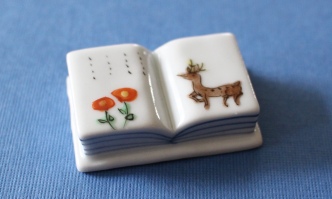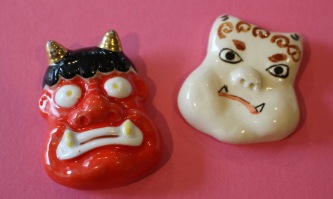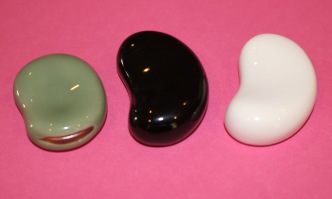One of the highlights of my trip to Japan in October 2016 was a visit to the Miho Museum near Shigaraki, in Shiga Prefecture, and about an hour outside of Kyoto.
The museum itself was amazing, beginning with a walk or ride though a long tunnel to reach the museum building which is actually partially buried under a mountain. Architect I.M. Pei removed a mountain or hill to create the building site for the museum, and then he returned the dirt, trees and shrubs to restore most of the natural pre-build landscape. The exhibition space inside the building is superb. When I was there one of the exhibits was a fabulous display of 18th. century ceramics by Ogata Kenzan which are owned by the same mother and daughter who provided the funding for the museum.
But enough about the museum; this is a blog about hashioki.
 It just so happens that I got a fabulous hashioki at the Miho Museum. It is a handmade, artisan-created hashioki, made by a husband who is a ceramicist and a wife who is a painter. It is signed “Ametsuchi” in hiragana on the bottom. As you can see, it is in the shape of an open book, and the pages are so detailed that you almost think you can turn them. The hashioki features some traditional Japanese design motifs: running grass script, flowers, and a deer. The piece is either one-of-a-kind or maybe one-of-a-few-of-a-kind, which seems very appropriate for a one-of-a-kind museum like the Miho Museum. I don’t know if the piece relates to an item in the museum’s collection (like the hashioki from the MOA Museum in Atami featured in my post “Smart Merchandising” in January 2016), but I treasure it anyway.
It just so happens that I got a fabulous hashioki at the Miho Museum. It is a handmade, artisan-created hashioki, made by a husband who is a ceramicist and a wife who is a painter. It is signed “Ametsuchi” in hiragana on the bottom. As you can see, it is in the shape of an open book, and the pages are so detailed that you almost think you can turn them. The hashioki features some traditional Japanese design motifs: running grass script, flowers, and a deer. The piece is either one-of-a-kind or maybe one-of-a-few-of-a-kind, which seems very appropriate for a one-of-a-kind museum like the Miho Museum. I don’t know if the piece relates to an item in the museum’s collection (like the hashioki from the MOA Museum in Atami featured in my post “Smart Merchandising” in January 2016), but I treasure it anyway.


 This blue and white cloud is a chopstick rest from the Italian design firm of Alessi. (Another Alessi hashioki is featured in my post “Gotta love this fish” from August 2016.) It reminds me of the clouds that sometimes obscure the transition between different scenes on a Japanese folding screen (byobu) or scroll, especially when that art work has a “bird’s eye perspective” which invites the viewer to look down on a house or garden from above.
This blue and white cloud is a chopstick rest from the Italian design firm of Alessi. (Another Alessi hashioki is featured in my post “Gotta love this fish” from August 2016.) It reminds me of the clouds that sometimes obscure the transition between different scenes on a Japanese folding screen (byobu) or scroll, especially when that art work has a “bird’s eye perspective” which invites the viewer to look down on a house or garden from above. Valentine’s Day is celebrated a little differently in Japan than it is in the US. The primary gift is chocolate, not flowers or jewelry, and the holiday is all about women presenting those gifts of chocolate to men. Here’s a link to a great description posted by Makiko Itoh in 2016 on her blog Just Hungry:
Valentine’s Day is celebrated a little differently in Japan than it is in the US. The primary gift is chocolate, not flowers or jewelry, and the holiday is all about women presenting those gifts of chocolate to men. Here’s a link to a great description posted by Makiko Itoh in 2016 on her blog Just Hungry:  Japan has a long tradition of scary tales, and many of them feature oni, which can be translated as devils, demons, or ogres.
Japan has a long tradition of scary tales, and many of them feature oni, which can be translated as devils, demons, or ogres. While oni are associated with evil, they are not always frightening. Sometimes they are treated quite humorously, as the red oni on the black pebble hashioki here illustrates. This fellow wears a tiger loincloth, and carries a kanabō, or spiked iron club, which are both standard issue for oni demons. The expression oni ni kanabō, written in
While oni are associated with evil, they are not always frightening. Sometimes they are treated quite humorously, as the red oni on the black pebble hashioki here illustrates. This fellow wears a tiger loincloth, and carries a kanabō, or spiked iron club, which are both standard issue for oni demons. The expression oni ni kanabō, written in  hiragana and kanji in the gold box on the left side of the rest, means “oni with an iron club,” and suggests a power so strong that it is unbeatable.
hiragana and kanji in the gold box on the left side of the rest, means “oni with an iron club,” and suggests a power so strong that it is unbeatable. soybeans — smaller versions of these hashioki beans — are used to dispel evil spirits. Somebody dons a oni mask, and then the other members of the family hurl soybeans at them while chanting Oni wa soto, fuku wa uchi, or “Out with the demons! In with good luck!”(1)
soybeans — smaller versions of these hashioki beans — are used to dispel evil spirits. Somebody dons a oni mask, and then the other members of the family hurl soybeans at them while chanting Oni wa soto, fuku wa uchi, or “Out with the demons! In with good luck!”(1)